Grass Sod Options in Denton, TX: A Complete Guide
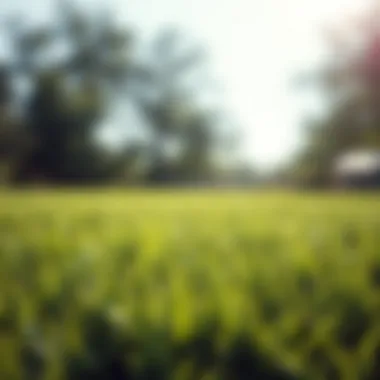
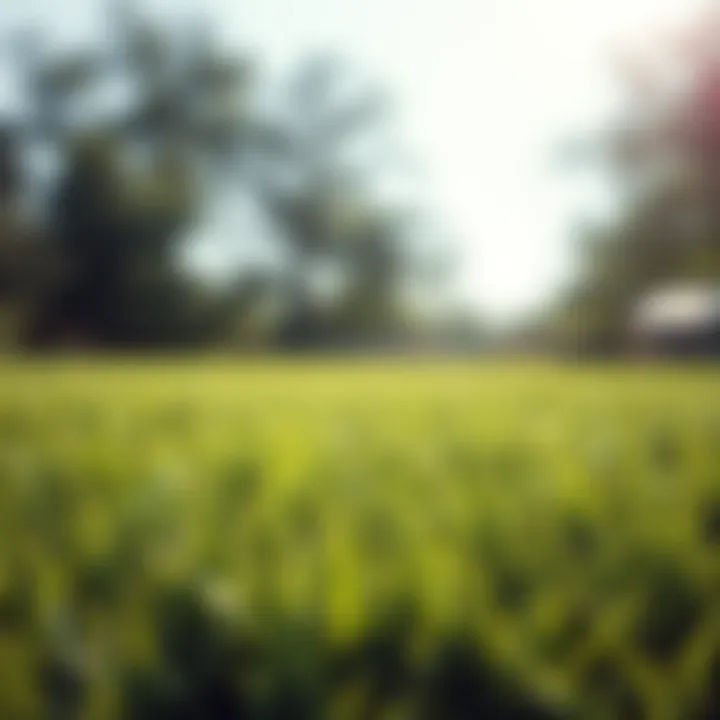
Intro
Grass sod has blossomed into a popular choice for maintaining lush green lawns in Denton, Texas. With its practicality and aesthetic appeal, more and more homeowners are trading traditional seeding methods for the instant gratification that sod provides. The climate in Denton, which ranges from hot summers to mild winters, necessitates specific types of grass that can withstand local weather patterns while ensuring a vibrant yard.
This guide aims to unpack the world of grass sod— dissecting the various options available, discussing installation methods, and unveiling maintenance tips tailored to Denton’s unique landscape. We will also touch on the environmental implications of choosing sod versus seeding, cost considerations, and best practices for those looking to achieve a healthy lawn that flourishes year-round.
Prelude to Grass Sod
Understanding grass sod is more than just a backyard concern; it's about creating a living canvas that integrates with our environment and enhances our way of life. In Denton, Texas, where the climate can sway significantly between the toasty Texas summers and the cooler winters, the choice of grass plays a pivotal role in landscaping projects. Grass sod, as opposed to seeding, presents a faster solution to the quest for a lush lawn, allowing homeowners and landscape enthusiasts alike to enjoy immediate results.
By laying down sod, you're setting the stage for a vibrant outdoor space that can withstand the test of time, moisture, and the occasional drought. This section provides a foundation to understand not only what grass sod entails, but how it can elevate both residential lawns and commercial landscapes.
Understanding Grass Sod
Grass sod consists of pre-grown grass, roots, and soil layers that are rolled out for installation. It's a simple yet effective way to establish a vibrant, green lawn almost instantly. Think of it as a tapestry of grass that has been nurtured to create a seamless, uniform look from the outset. In Denton, where the soil type and climate can be somewhat unpredictable, selecting the right type of sod is crucial.
The benefits of grass sod include:
- Instant Gratification: Once installed, grass sod offers an almost instant lawn without the burden of waiting for seeds to germinate and spread.
- Erosion Control: With established roots, sod helps in preventing soil erosion, particularly important in regions with heavy rain.
- Weed Resistance: Sodded lawns, due to their dense coverage, are less susceptible to weeds compared to newly seeded areas.
It's important to consider factors like soil condition, grass type, and local climate when choosing the right sod. Each layer of sod can be critical to your lawn's longevity and overall health.
Importance in Landscaping
In landscaping, grass sod is not merely an aesthetic choice but also a functional one. Lawns are often the first aspect of a property seen by visitors, so creating a visually appealing lawn can contribute significantly to curb appeal. A well-maintained sod lawn can also increase property value and make spaces more inviting.
Furthermore, a robust grass sod offers various environmental benefits. It helps absorb rainfall, reduces runoff, and can even improve air quality. Additionally, grass creates a habitat for numerous local organisms, fostering biodiversity in the area. The investment in quality sod yields dividends in both enjoyment at home and a greater appreciation for nature’s intricate systems.
Ultimately, understanding grass sod is essential for anyone looking to cultivate a successful and lasting lawn in Denton, TX. By familiarizing yourself with the ins and outs of sod installation and maintenance, you're setting yourself up for a scenic and sustainable outdoor environment.
Grass Types Suitable for Denton, TX
Choosing the right grass type is critical for a successful lawn in Denton, Texas. With its unique climate, understanding which grasses flourish here can significantly impact the overall health and appearance of your yard. Denton experiences a mix of warm and occasional cool weather, making it essential to select grasses that can tolerate heat, drought, and periods of cooler temperatures.
Warm-Season Grasses
Buffalograss
Buffalograss stands out as a tough champion of the Texan landscape. Its ability to thrive in the hot, dry conditions of Denton makes it a popular choice among homeowners. This native grass, characterized by its fine, soft texture, embraces drought-like a well-loved sibling. Unlike some grasses which turn brown in extreme heat, Buffalograss typically remains green with minimal water.
Moreover, its low maintenance needs make it appealing. It demands less fertilization and is resistant to many pests and diseases. One unique feature of Buffalograss is its deep root system, which helps retain soil moisture effectively. However, on the flip side, it can struggle in shaded areas and might not hold up well under heavy foot traffic.
Bermudagrass
Bermudagrass is a widely favored option for lawns and sport fields, particularly in Denton. Known for its vibrant green color and rapid growth, this grass creates a robust, hardy lawn. It's a fantastic choice for those seeking a lush and easy-going outdoor space. The best part? Bermudagrass can handle significant heat and moisture loss. Its fast establishment means that you will have a full lawn quicker than with other types.
However, Bermudagrass has a unique quality: it tends to go dormant during winter months, turning brown until spring arrives. Homeowners need to consider this seasonal change in appearance. Additionally, it requires regular mowing and can become invasive if not properly managed.
Zoysiagrass
Zoysiagrass is another contender worth considering, providing an exceptional balance of strength and aesthetic appeal. This grass can comfortably handle heat while maintaining a lush green color. Known for its thick, carpet-like texture, it’s perfect for lawns subjected to various activities.
One of its standout features is its heat tolerance combined with shade adaptability. You can find Zoysiagrass thriving even in partially shaded areas, unlike some warm-season alternatives. Though this grass grows slower compared to others, which might prolong establishment. It also necessitates proactive care, as it can suffer from certain pests if neglected.
Cool-Season Grasses
Fescue
Fescue is excellent for homeowners who prioritize a soft, plush lawn that also tolerates some shade. Its adaptability to cool months makes it ideal for these Texas transitional weather conditions. With a rich green hue, this grass adds a visually pleasing element to any landscape.
Fescue offers superior drought resistance and has a unique deep rooting system, helping it absorb moisture more deeply compared to superficial-rooted grasses. A potential downside includes its susceptibility to diseases in hot, humid conditions, which can be especially problematic in the summer heat of Denton.
Kentucky Bluegrass
Kentucky Bluegrass is renowned for its rich texture and vibrant color, making it a popular choice for cooler areas. Its ability to provide a dense, lush lawn that's pleasing to the eye is invaluable. This grass type also spreads quickly, filling in bare patches with ease, a feature that gardeners appreciate.
While Kentucky Bluegrass is aesthetically pleasing, it does have its quirks. It requires consistent moisture and can struggle in the heat of summer, thus demanding more watering during drought. Additionally, its longer establishment period might delay your lawn's full potential compared to faster-growing warm-season varieties.
Perennial Ryegrass
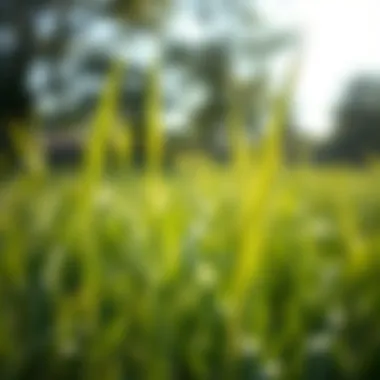
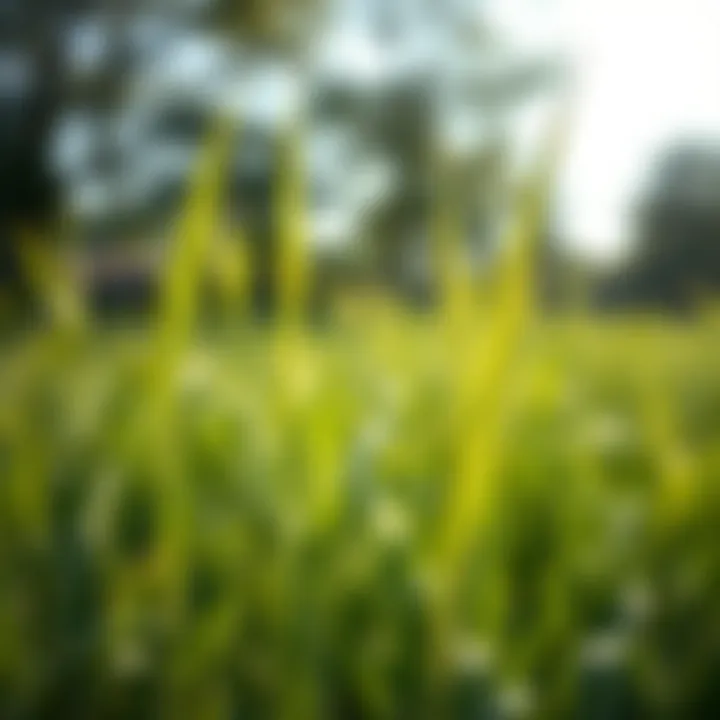
Perennial Ryegrass is all about quick results, allowing for rapid establishment and a lush appearance almost overnight. It germinates quickly, which is why it's often used in overseeding scenarios, helping maintain lushness as other grasses recover. One of its defining factors is its bright green, lush blades that make lawns look inviting.
However, it isn't without flaws. This type usually requires more frequent watering and can be susceptible to heat stress, especially during dry summers. Additionally, it tends to go dormant and brown by late spring, making it less suitable for someone looking for consistent year-round greenery.
Hybrid Grass Varieties
While the options are various, hybrid grass varieties meld the strengths of both warm and cool-season grasses, offering an innovative solution to Denton homeowners. Hybrid grasses like the ‘Tifway 419’ have become increasingly popular as they exhibit both resilience and an appealing aesthetic. They can tolerate heat while still providing a lush look during cooler months, striking a balance that's hard to beat. Like with all grass types, knowing your garden’s conditions and maintenance capabilities will aid in making the best selection for your specific situation.
Installation of Grass Sod
Installing grass sod can be seen as the backbone of achieving a beautiful and healthy lawn. The way sod is laid down can have lasting impacts on its longevity and vitality. It's not just about tossing the rolls onto the dirt; it requires careful planning and a few essential steps to ensure a robust growth afterwards. Understanding the nuances of sod installation helps to mitigate common issues that arise and to maximize the functionality of the sod. Moreover, knowing when and how to do it right means less hassle down the road.
Site Preparation
Proper site preparation paves the way for successful sod installation. This phase involves several key activities, each contributing significantly to the overall outcome.
Soil Testing
Soil testing is crucial for any successful sod project. It offers insights into the nutrient content and pH level of your soil, which can have a profound effect on grass health. By knowing what your soil actually needs, you can tailor amendments accordingly. This targeted approach improves sod establishment and health.
The unique advantage of soil testing is that it takes the guesswork out of lawn care. Rather than introducing a myriad of fertilizers and amendments, you focus on what’s necessary for your soil's unique composition. This not only fosters better grass growth, but it can also save time and money. On the downside, soil testing may seem like an extra chore for some, but in the long run, it provides invaluable information.
Clearing and Leveling
Before laying sod, clearing and leveling the area is key. This means removing rocks, weeds, and debris to create a clean slate. Uneven surfaces can cause sod to dry out in certain areas due to poor water distribution, leading to patches in the lawn. A level area guarantees that water drains effectively, promoting healthier sod establishment.
The main characteristic here is simplicity—by clearing and leveling, you immediately give your sod a better chance to thrive. However, depending on your yard’s size, this step can become quite labor-intensive. But fear not, the fruits of your labor will be well worth it.
Amendment Considerations
Adding amendments based on soil test findings elevates the preparedness of the planting site. Amending the soil with organic matter, compost, or specific nutrients can significantly improve soil structure. This creates a hospitable environment for new roots to take hold.
The value of amendments lies in their ability to enrich the soil, thus facilitating better water retention and nutrient availability. While there is an initial cost and time investment involved in this process, the long-term benefits of a robust lawn can far outweigh these considerations, making it a worthy investment.
Choosing the Right Time
Timing plays a critical role in the success of sod installation. Choosing the right moment can elevate the health and resilience of your sod.
Seasonal Factors
Understanding seasonal factors is essential when planning for sod installation. In Denton, the climate can vary dramatically, with hot summers and mild winters. Late spring or early fall are often recommended times; temperatures are more favorable for root establishment.
One key aspect of seasonal timing is its influence on soil temperatures and moisture availability. Proper timing helps sod roots integrate with the soil more effectively, leading to healthier growth. Conversely, installing sod during extreme temperatures can stress new grass and lead to failure.
Temperature Considerations
Temperature considerations go hand in hand with seasonal factors. Ideal temperatures for most grasses typically range from 65°F to 80°F. When these conditions are met, water absorption and nutrient uptake can occur more smoothly.
The notable characteristic of temperature is its direct influence on sod health. Grass laid down in cooler conditions might take longer to establish; conversely, under hot conditions, it may suffer from heat stress. Therefore, timing your installation based on accurate temperature predictions is a smart tactic.
Laying the Sod
Finally, once these preparations are in place, it’s time for the main event—laying down the sod correctly. This task requires attention to detail, ensuring pieces fit snugly together without gaps. It is often said that a well-laid sod is half the work done for a stunning lawn, as it helps eliminate weeds and encourages even water distribution. Efforts in this final step ensure that all preceding work pays off, delivering a plush, green carpet for you and your family to enjoy.
Maintenance of Grass Sod
Proper maintenance of grass sod is not just a chore; it's the lifeblood of sustaining a vibrant lawn, especially in a specific climate like Denton, TX. It ensures that the grass stays green, healthy, and resistant to various stresses. When it comes to sod, neglect can lead to a number of issues, such as browning, patchy growth, or even the wilted look that nobody wants in their yard. Good maintenance practices help optimize the sod's performance and longevity.
Watering Techniques
Frequency and Amount
The frequency and amount of watering are crucial to maintaining a healthy sod. Most lawns need about one to two inches of water per week, which can be adjusted depending on the rainfall. Overwatering can suffocate roots, making it a double-edged sword; while it may seem like a good idea to keep your sod drenched, too much water can lead to rot and fungal diseases. On the flip side, underwatering may stress the grass, leading to brown patches and slower growth. Regularly checking the soil moisture helps you find that sweet spot.
- Key takeaways about watering:
- Aim for one to two inches of water weekly.
- Monitor rainfall to adjust watering schedules.
- Avoid both overwatering and underwatering to keep your grass thriving.
Best Practices
There are several best practices when it comes to watering. Early morning is generally the most favorable time to water your sod. This time allows the grass to absorb moisture before the sun really gets going, reducing evaporation. Also, consider using a soaker hose or drip irrigation, which helps put the water right where it’s needed, minimizing wastage. It's not just about quantity but quality as well; consistent watering times lead to a healthier lawn.
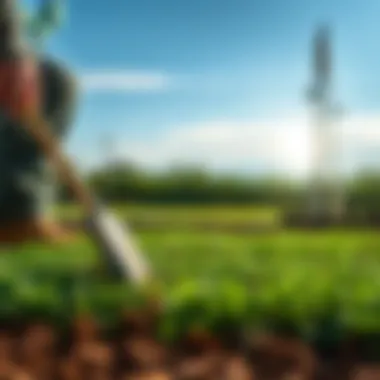
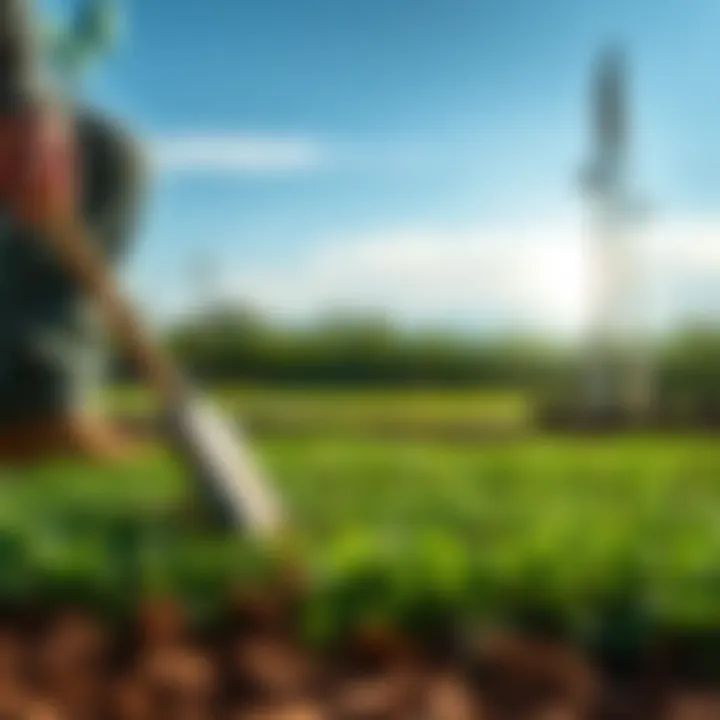
- Watering Best Practices:
- Water early in the morning.
- Use efficient irrigation systems like soaker hoses.
- Set a consistent schedule to improve lawn health.
Fertilization
Nutrient Requirements
Understanding nutrient requirements is crucial for optimal growth and health of your sod. Grass needs different nutrients like nitrogen, phosphorus, and potassium at varying levels to grow well. A soil test can give a clear picture of what nutrients your soil lacks. Too much fertilizer can burn the grass, while too little can give rise to a weak and unhealthy lawn. Thus, knowing these nutrient specifics helps you provide balanced care.
- Key Nutrients:
- Nitrogen: for growth.
- Phosphorus: for root development.
- Potassium: for overall health and heat tolerance.
Timing and Application Methods
Fertilizing at the right time enhances the benefits you reap from it. Spring and fall are generally considered the best times for fertilizing, as this aligns with the growth cycles of grass. Application methods can vary; using a broadcast spreader ensures an even distribution, preventing any nutrient burn in some areas while leaving others without sufficient nourishment. Over time, strategizing your fertilization timing and methods can make all the difference in your lawn’s appearance.
- Application Tips:
- Fertilize during growth seasons: spring and fall.
- Use a broadcast spreader for even coverage.
- Monitor the lawn condition to adjust future applications.
Mowing Practices
Optimal Height
Mowing your sod at the optimal height is vital for its health. Generally, a height of around two to four inches is recommended, depending on the grass type. Cutting too short can stress the grass, making it more susceptible to drought and diseases. Taller blades provide shade to the roots and minimize weed growth, which is always a plus. Regularly monitoring grass height allows you to catch any issues before they escalate, keeping your lawn looking sharp.
- Mowing Tips:
- Aim for two to four inches in height.
- Avoid cutting too short to maintain health.
- Consistent check-ups on height ensure a tidy lawn.
Tools and Equipment
Having the right tools can greatly improve your mowing efficiency and effectiveness. A sharp mower blade is essential; dull blades can tear the grass, leaving it vulnerable to diseases. Additionally, consider choosing a mower that suits your terrain—self-propelled mowers are great for hilly areas, while electric models can be quieter and more eco-friendly. Investing in the right equipment can save time and result in a healthier lawn over time.
- Helpful Mowing Equipment:
- Sharp mower blades for clean cuts.
- Self-propelled for tougher terrains.
- Electric mowers for quieter operation.
Regular maintenance ensures your sod not only survives but thrives. A well-kept lawn adds beauty and value, so take time to get it right.
Soil and Environmental Considerations
Understanding the relationship between grass sod and its soil environment is crucial for creating a thriving lawn in Denton, TX. The quality of soil directly affects the health of the grass, influencing not only its growth but its resilience to pests and diseases. Healthy soil promotes root development, allows for nutrient absorption, and helps retain moisture, which is essential in maintaining a vibrant lawn, especially in the varying climates of Denton.
While selecting grass sod, one should not overlook environmental factors. Proper assessment and consideration of local environmental conditions can lead to more sustainable practices that enhance the ecological well-being of the area.
Soil Health Assessment
Evaluating the soil health is the first step in ensuring that the grass sod flourishes. A soil test should be conducted, revealing vital information such as pH levels, nutrient content, and organic matter. This process not only helps in understanding the baseline health of the soil but also guides any amendments that may be necessary.
When assessing soil
- Check pH Levels: Ideal pH for grass growth typically ranges from 6.0 to 7.0. Testing kits are readily available for this task.
- Nutrient Analysis: This helps to determine deficiencies in nitrogen, phosphorus, and potassium, which are critical for growth.
- Soil Texture: Understanding the soil’s texture can help in water drainage considerations and the type of grass sod that can thrive.
By proactively addressing soil health, a gardener can lay the groundwork for a successful sod installation and maintenance process, paving the way for healthier, greener lawns.
Environmental Impact of Grass Sod
In recent years, the topic of environmental sustainability has gained traction within the realm of landscaping, including the use of grass sod. Choosing to establish sod lawns instead of traditional seeding can offer several benefits, impacting both local ecosystems and the broader environment.
Biodiversity Benefits
Biodiversity is not merely a buzzword; it's a crucial aspect of maintaining ecological balance. Grass sod can offer a habitat for various organisms, aiding in promoting local biodiversity. A dense mat of sod reduces soil erosion, provides shade, and acts as a refuge for small animals and insects, which contribute to the overall ecosystem health. By planting a variety of grass types and incorporating native species in the sod, homeowners can have a more varied habitat that supports local wildlife.
Some significant points about biodiversity benefits include:
- Providing Shelter: Grass roots tend to hold soil together, reducing erosion, and creating habitats for organisms.
- Supporting Pollinators: Specific grass species may attract pollinators, which are essential for the growth of other plants.
This characteristic makes sod a beneficial choice for those aiming to increase the ecological footprint of their property.
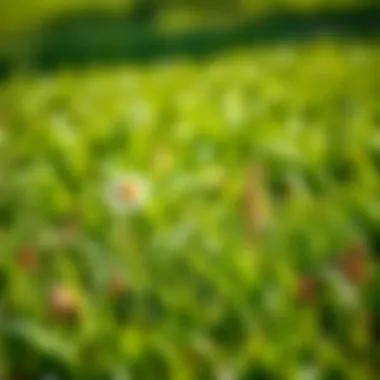
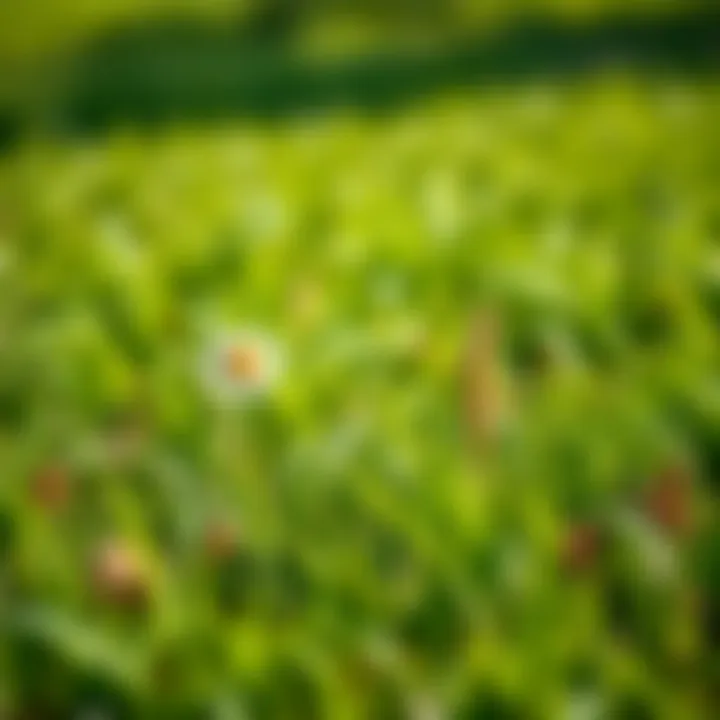
Climate Resilience
Climate resilience refers to the ability of the ecosystem to withstand and recover from adverse weather conditions. Grass sod is typically more adaptive to variable weather patterns, proving crucial in areas like Denton, where sudden temperature shifts can occur.
Investing in climate-resilient sod can mean choosing heartier grass varieties that endure drought, stress, and pests better than others. Some unique features of sod embrace:
- Drought Resistance: Certain sod types require less irrigation, thus conserving water—an invaluable resource.
- Temperature Tolerance: Robust grass varieties can maintain health despite extreme temperatures, enhancing sustainability.
By focusing on climate resilience, homeowners are not just investing in the aesthetic value of their lawns, but they're also contributing to broader environmental sustainability goals. In essence, understanding and cultivating healthy soil alongside implementing environmentally-friendly practices can result in a positive cycle benefiting both local ecosystems and homeowners alike.
Cost Analysis of Grass Sod
Understanding the financial implications of grass sod is essential for anyone looking to cultivate a lush green lawn in Denton, TX. This section sheds light on several specific elements that influence sod choice and overall landscaping investments. The benefits of sod must be weighed against its associated costs to ensure that the decision aligns with both short and long-term landscaping goals.
Initial Investment vs. Long-term Benefits
When it comes to grass sod, the initial investment can hit the wallet a little harder than merely sowing seeds. However, buyers should keep their eyes on the bigger picture. The cost of sod generally encompasses the purchase price, delivery fees, and installation expenses. This upfront layout can be significant but can yield a variety of long-lasting benefits.
Opting for sod often results in quicker establishment of a lush lawn. In the throes of germination, grass seeds might take weeks or even months to grow, while sod can be ready for use in just a few days after installation. This fast turnaround helps in preventing erosion and muddy patches that can occur in bare soil.
Some things to consider:
- Time and labor savings: Laying down sod requires less maintenance initially compared to seeded lawns, which need more ongoing care and attention.
- Increased property value: A well-maintained sod lawn can increase your property’s curb appeal and overall market value over time.
- Reduced weed infiltration: A thicker sod layer discourages weeds from sprouting, leading to less money spent on herbicides and weed management.
From this perspective, while the initial investment might be daunting, the long-term advantages of sod can offset the costs significantly.
Cost of Installation
The cost of installing sod can vary widely based on several factors including lawn size, sod type, and whether you’re hiring a professional or going the DIY route.
If you decide to go professional, installation costs can rise substantially due to labor fees. Local landscaping companies in Denton might charge around $1 to $2 per square foot for labor, which can add up quickly for larger areas. Alternatively, DIY installation might save some bucks but requires time, effort, and a bit of know-how.
Here are a few elements that can influence the overall cost of sod installation:
- Size of the area: Larger spaces will require more sod and more time to lay it down.
- Soil preparation needs: Poor soil conditions might necessitate additional steps such as tilling or amending with topsoil, which can increase costs.
- Sod type: The cost also varies with the type of sod chosen. For example, premium varieties like Zoysiagrass often come at a higher price compared to more common types like Bermudagrass.
Common Issues and Solutions
Understanding the common issues faced with grass sod is crucial for anyone looking to maintain a verdant lawn in Denton, Texas. Grass sod provides quicker results than seeding, but it comes with its own set of challenges. Identifying and tackling these problems early can save you both time and money. Moreover, addressing these concerns keeps your lawn looking sharp and healthy year-round. While the benefits of grass sod in Denton are plentiful, aware leisure and professionals might face hurdles. Let's look into two significant aspects of grass sod management: pest management and disease prevention, which play a pivotal role in ensuring your lawn remains lush and green.
Pest Management
Pest management is key for maintaining a vibrant grass sodded lawn. In Denton, just like any other place, pests can wreak havoc on newly laid sod if left unchecked. The first step in dealing with pests is recognizing what’s lurking around. Common culprits include grubs, chinch bugs, and armyworms. These pests can undermine the health of your grass by feeding on the roots and stems, leading to patchy areas and unhealthy growth.
To keep these unwanted guests at bay, consider the following tips:
- Regular Inspections: Make it a habit to check your lawn often, especially after periods of significant rainfall. Look for signs of pest activity like discoloration or wilting.
- Natural Predators: Encourage beneficial insects such as ladybugs and lacewings which feast on harmful pests.
- Pesticides: If the infestation is beyond control, don't hesitate to use pesticides. Select a product that is safe to apply on sod and ensure it targets the specific pest you are facing. Always read the label! A specific example would be using Bacillus thuringiensis for caterpillar control, as it can be effective without harming beneficial insects.
“An ounce of prevention is worth a pound of cure.” Keeping your lawn healthy can lessen the likelihood of pest problems and enhance your overall lawn care experience.
Disease Prevention
Like pests, diseases can sabotage your newfound green carpet very quickly. In Denton, the weather can aid various fungal and bacterial issues that might affect your grass. For instance, brown patch, dollar spot, and root rot are common diseases that can turn your grass sodding efforts into a struggle. Protecting your sod from these ailments requires a proactive approach.
Here are some preventive measures:
- Soil Health: Healthy soil is a strong defense. Regular testing can help you gauge nutrient levels and pH balance, which are vital for healthy sod.
- Water Management: Excessive or inadequate watering creates favorable conditions for diseases. It’s critical to have a consistent watering schedule that allows grass roots to absorb moisture without sitting in it.
- Aeration: Aerating your lawn helps improve drainage and reduces soil compaction, which can lead to diseases. This practice enhances water infiltration and air circulation, crucial for root health.
- Proper Mowing: Keeping your grass at the appropriate height prevents stress and can make it less susceptible to diseases. Ensure your mower blades are sharp to avoid tearing the grass.
By anticipating problems related to pest management and disease prevention, you can foster a thriving grass sod lawn that stands the test of time in Denton, TX. Taking these steps seriously will not only enhance the aesthetics of your landscape but also deliver a robust lawn that beckons enjoyment for all who tread upon it.
Finale
As we wrap up our exploration of grass sod in Denton, TX, it’s essential to reflect on why this topic holds significant weight for both seasoned landscapers and casual gardening enthusiasts. A healthy lawn does not simply enhance the beauty of one’s property; it serves a deeper purpose in promoting environmental sustainability and providing functional benefits. Grass sod—when chosen, installed, and maintained properly—brings lushness and vitality to the landscape, ultimately enriching the local ecosystem.
In this article, we have covered various elements crucial to understanding grass sod. From the different types of grasses suitable for Denton's climate—such as Buffalograss and Bermudagrass—to the critical processes of installation and maintenance, each section serves to equip readers with pertinent knowledge. Moreover, we discussed cost analyses and common issues, ensuring that both financial considerations and potential hurdles are addressed.
Recap of Key Points
- Types of Grass: Recognizing the ideal grass varieties for Denton’s warm climate is pivotal. Warm-season grasses are more prevalent, but incorporating cool-season ones at the right time can provide diversity and durability.
- Installation Techniques: Proper site preparation, optimal timing for laying sod, and the actual installation process are fundamental to achieving a successful outcome. Soil health cannot be overlooked, thus testing and amending it for suitability should be foundational steps.
- Maintenance Routines: Effective watering practices, timely fertilization, and appropriate mowing techniques contribute significantly to the longevity and health of sod.
- Environmental Impact: Grass sod aids in promoting biodiversity, reducing soil erosion, and improving air quality. In a world increasingly stricken by climate challenges, these benefits are more relevant than ever.
- Cost Insights: Understanding the initial investment versus long-term advantages demonstrates to homeowners and businesses alike that quality sod can lead to increased property value and reduced maintenance costs over time.
Future Trends in Grass Sodding
Looking forward, the turf industry is undergoing rapid transformation, driven by innovations and sustainable practices. Here are a few trends likely to shape the future of grass sodding in Denton and beyond:
- Eco-Friendly Grasses: More homeowners are seeking varieties that require less water and maintenance. Research into drought-resistant species is on the rise, catering to those aiming for sustainability without sacrificing aesthetics.
- Technological Integration: Automation in lawn care through smart irrigation systems and monitoring apps will facilitate more precise and efficient maintenance practices. This intersection between technology and landscaping can streamline tasks while reducing resource use.
- Native Grass Promotion: There’s a growing movement towards using native grasses that support local wildlife. These varieties are designed to thrive in their native ecosystems, allowing for a more harmonious balance between cultivated spaces and natural habitats.
- Focus on Organic Practices: As concerns over pesticides and synthetic fertilizers mount, there’s a shift towards organic lawn care solutions. Emphasis on natural fertilization and pest management methods are attracting environmentally conscious consumers.
Conclusively, the journey of integrating grass sod into landscaping in Denton goes beyond aesthetics. It intertwines with ecological responsibility and the evolving needs of our environment. For anyone looking to beautify their space, understanding and adopting these insights is essential for future growth.







